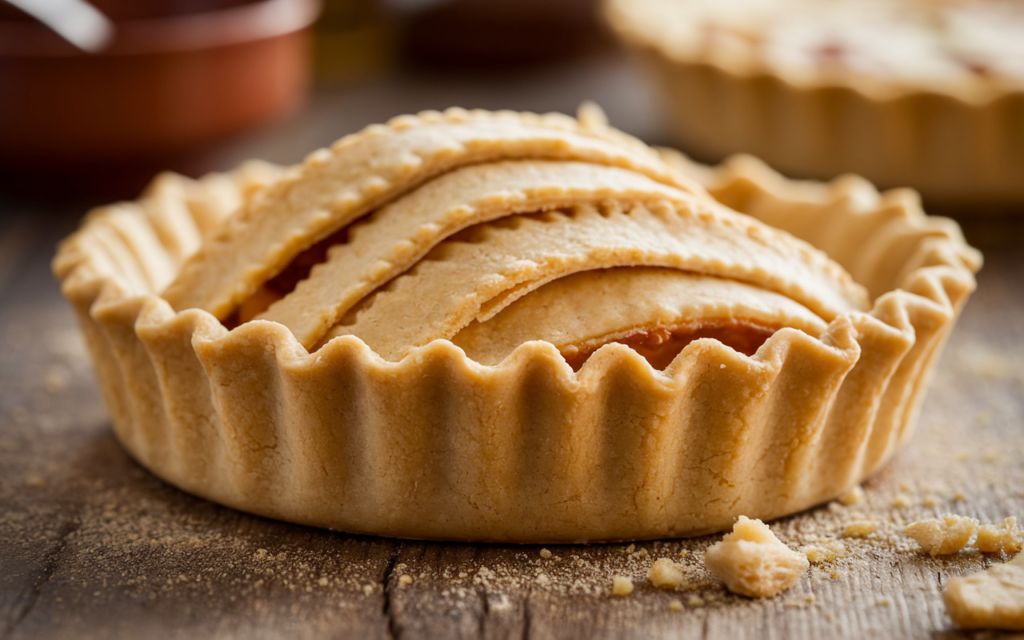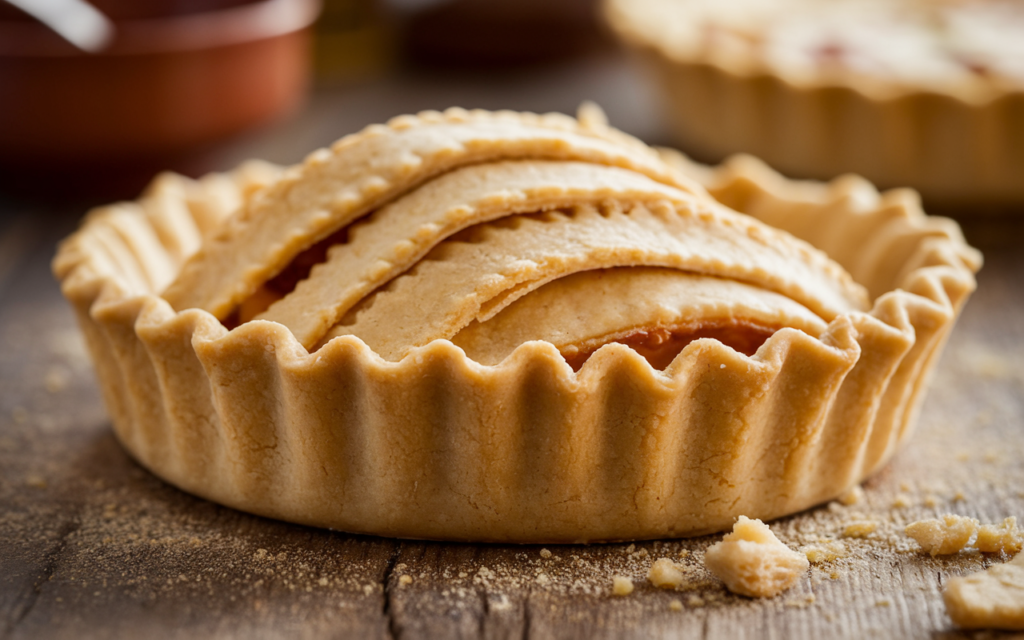A perfect pie crust can elevate any dessert. Among the various methods, a Crisco pie crust recipe stands out for its unbeatable flakiness and easy-to-follow steps. In this article, we’ll explore everything you need to know to master this classic recipe, from essential techniques to troubleshooting tips.
Why Choose Crisco for Your Pie Crust?
Using Crisco, or vegetable shortening, in pie crust recipes is a time-tested tradition for good reasons:
- Flakiness: Crisco’s high melting point creates distinct layers, resulting in a flaky texture.
- Ease of Use: Unlike butter, Crisco is forgiving and easy to handle, even for beginners.
- Neutral Flavor: It lets your pie fillings shine without overpowering them.
Learn more about shortening and its uses in baking.
Ingredients for a Classic Crisco Pie Crust
For a single crust:
- 1 ¼ cups all-purpose flour
- ½ teaspoon salt
- ⅓ cup + 1 tablespoon Crisco shortening
- 3–4 tablespoons ice-cold water
For a double crust:
- 2 ½ cups all-purpose flour
- 1 teaspoon salt
- ⅔ cup + 2 tablespoons Crisco shortening
- 6–8 tablespoons ice-cold water
Tip: Keep all ingredients cold to ensure the best results.

Step-by-Step Crisco Pie Crust Recipe
Step 1: Combine Dry Ingredients
- In a medium bowl, whisk together the flour and salt.
- This ensures even distribution of salt, a crucial step for flavor.
Step 2: Cut in Crisco
- Add Crisco to the bowl.
- Use a pastry cutter or two knives to cut the shortening into the flour until the mixture resembles coarse crumbs.
Pro Tip: Work quickly to avoid warming the shortening.
Step 3: Add Ice Water
- Gradually sprinkle ice water over the mixture, one tablespoon at a time.
- Stir gently with a fork until the dough begins to hold together.
Important: Avoid overworking the dough to maintain its flaky texture.
Step 4: Chill the Dough
- Gather the dough into a ball, flatten it into a disk, and wrap it in plastic wrap.
- Refrigerate for at least 30 minutes to relax the gluten and keep it cold.
Step 5: Roll Out the Dough
- On a floured surface, roll out the chilled dough into a circle about 1/8 inch thick.
- Transfer it to your pie dish and trim excess dough, leaving a ½-inch overhang.
Pro Tip: Avoid stretching the dough to prevent shrinkage during baking.
Troubleshooting Common Crisco Pie Crust Issues
- Why is my Crisco pie crust falling apart? This often happens if there’s too little water or the dough was overmixed.
- Why add vinegar to pie crust? Vinegar can help tenderize the dough and inhibit gluten formation, resulting in a softer crust.
- What is one thing you should not do when making pie crust? Never overwork the dough, as it will become tough instead of flaky.
Explore more tips for perfect pie crusts.
The Science Behind Flaky Pie Crusts
The secret to a perfectly flaky pie crust lies in the science of baking. The fat in the crust, in this case, Crisco shortening, plays a pivotal role in creating those delicate layers. Crisco has a higher melting point compared to butter, allowing it to maintain its solid state longer as you handle the dough. This characteristic is crucial for achieving flakiness because solid fat forms steam pockets during baking, which lift and separate the layers of dough.
Additionally, Crisco’s neutral flavor ensures it doesn’t overpower your fillings, making it an ideal choice for sweet and savory pies alike. Minimizing gluten formation is also essential for a tender crust. This is why you should handle the dough gently and avoid overmixing. Excessive mixing activates the gluten in the flour, resulting in a tough crust.
Alternative Variations for a Crisco Pie Crust
A traditional Crisco pie crust recipe is beloved for its reliability, but variations can help you cater to dietary needs or explore new flavors:
- Whole Wheat Crust: For a nuttier flavor and added fiber, replace half of the all-purpose flour with whole wheat flour. While it won’t be as light as the classic version, the richness pairs beautifully with earthy fillings like pumpkin or pecan.
- Gluten-Free Crust: Gluten-free flour blends work well as substitutes. Add a teaspoon of xanthan gum if it’s not already included in the blend to provide elasticity and structure.
- Butter-Crisco Blend: For those who want a balance of buttery flavor and Crisco’s flakiness, use equal parts of both. This variation is excellent for fruit pies where a slightly richer crust enhances the overall flavor.
Experimenting with these options can help you find the perfect crust for every occasion.
Explore Healthy Baking Alternatives
Perfect Pairings for Crisco Pie Crust
Pairing your Crisco pie crust recipe with the right filling can transform it into a masterpiece. Here are some tried-and-true combinations:
- Sweet Fillings:
- Apple Pie: Classic and crowd-pleasing, apple pie is a natural partner for Crisco crust. The tender, flaky texture complements the soft, spiced apples perfectly.
- Berry Pies: Whether it’s blueberry, blackberry, or mixed berry, these pies benefit from the neutral flavor of the crust, allowing the fruit to shine.
- Custard Pies: Think silky pumpkin or rich chocolate custard. The lightness of the crust balances the dense filling beautifully.
- Savory Fillings:
- Quiches: A Crisco crust makes an excellent base for quiches. Its crispness contrasts wonderfully with the creamy egg filling.
- Chicken Pot Pies: For comfort food perfection, use this crust to encase a hearty chicken and vegetable filling.
- Vegetable Tarts: Add a touch of herbs to the dough for a savory twist.
Each of these pairings highlights the versatility of Crisco pie crust, making it a staple in any kitchen.

Seasonal Pies Made with Crisco Pie Crust
Creating seasonal pies with a Crisco pie crust ensures your desserts are always fresh and timely:
- Spring: Embrace the early harvest with a strawberry-rhubarb pie. The tartness of rhubarb pairs beautifully with the sweetness of strawberries.
- Summer: Use fresh, in-season berries like blueberries or blackberries for refreshing summer pies. A lattice crust design works particularly well for these juicy fillings.
- Autumn: Celebrate fall with classics like pumpkin pie, sweet potato pie, or a warm apple pie spiced with cinnamon and nutmeg.
- Winter: Hearty meat pies or mincemeat pies are perfect for cold winter evenings. Crisco’s flaky crust provides a comforting contrast to the rich, savory filling.
By adapting your crust to the season, you can create memorable pies year-round.
Decorative Techniques for Crisco Pie Crust
Presentation matters, especially for pies served on special occasions. With Crisco pie crust, you can easily craft visually stunning designs:
- Lattice Tops: Cut the dough into strips and weave them over your filling for a classic look. This is particularly great for fruit pies where the filling’s vibrant colors peek through.
- Braided Edges: Roll thin strips of dough and braid them before attaching to the pie’s edge. This creates an elegant border that elevates any pie.
- Cutouts and Shapes: Use cookie cutters to create stars, leaves, or hearts from excess dough. Lay these shapes on top of the pie or around the edges for a thematic design.
- Crimping Patterns: Use a fork or pinch the edges of the crust with your fingers for a decorative and functional finish.
These techniques not only enhance the pie’s appearance but also reflect your personal style as a baker.
Tips for Baking the Perfect Crust
No matter how experienced you are, achieving the perfect pie crust can be challenging. Here are some practical tips:
- Blind Baking: Essential for custard pies or any pie with a wet filling. Line the crust with parchment paper, fill it with pie weights, and bake partially before adding the filling.
- Preventing Sogginess: Brush the crust with an egg white wash before adding the filling. This creates a barrier that keeps the crust crisp.
- Avoiding Overbrowning: Check the pie after 15–20 minutes of baking. Cover the edges with aluminum foil or a pie shield if they’re browning too quickly.
These strategies ensure your pie crust looks as good as it tastes.
How to Reuse and Store Crisco Pie Crust Scraps
Don’t throw away leftover dough! There are countless ways to make the most of these scraps:
- Mini Tarts: Use a muffin tin to shape the scraps into small crusts and fill them with jam or custard.
- Crackers: Roll out the scraps, season with herbs or spices, and bake until crisp.
- Sweet Treats: Sprinkle scraps with cinnamon sugar, roll them up, and bake for quick pastry bites.
To store, wrap the scraps tightly in plastic wrap and freeze for up to two months. Thaw in the refrigerator before rolling out.
Tools and Equipment for the Perfect Crisco Pie Crust
The right tools can make all the difference when working with pie dough. Here’s what you’ll need:
- Pastry Cutter: Helps evenly distribute Crisco throughout the flour without overworking the dough.
- Rolling Pin: Choose a non-stick or wooden pin for smooth rolling.
- Pie Weights: These prevent the crust from puffing up during blind baking, ensuring an even surface.
- Bench Scraper: Handy for lifting dough from your work surface without tearing.
Investing in quality tools ensures consistent results and an easier baking process.
The Science Behind Flaky Pie Crusts
The secret to a perfectly flaky pie crust lies in the science of baking. The fat in the crust, in this case, Crisco shortening, plays a pivotal role in creating those delicate layers. Crisco has a higher melting point compared to butter, allowing it to maintain its solid state longer as you handle the dough. This characteristic is crucial for achieving flakiness because solid fat forms steam pockets during baking, which lift and separate the layers of dough.
Additionally, Crisco’s neutral flavor ensures it doesn’t overpower your fillings, making it an ideal choice for sweet and savory pies alike. Minimizing gluten formation is also essential for a tender crust. This is why you should handle the dough gently and avoid overmixing. Excessive mixing activates the gluten in the flour, resulting in a tough crust.

Frequently Asked Questions (FAQs)
Is pie crust better with butter or Crisco?
Crisco yields a flakier crust, while butter offers a richer flavor. For a balance, try a mix of both.
How do I keep my pie crust from shrinking?
Ensure the dough is properly chilled, and avoid stretching it when placing it in the pie dish.
Why is my pie crust greasy?
This could indicate that the shortening was too warm or the dough wasn’t chilled before baking.
Conclusion
Mastering a Crisco pie crust recipe is a game-changer for bakers looking to create consistently flaky, tender crusts for any pie. Whether you’re baking for a special occasion or simply indulging in a homemade treat, using Crisco ensures reliable results every time. By following this step-by-step guide and applying the pro tips provided, you’ll craft a pie crust that’s not only visually stunning but also irresistibly delicious. Experiment with variations, troubleshoot common issues, and let your creativity shine in the kitchen. A perfect pie starts with the perfect crust—and now you have the recipe for success!

